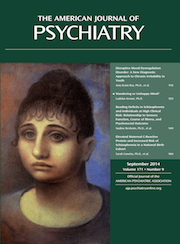Gilmore and Meersand have written a welcome update to the traditional psychodynamic development textbook. By including links to a curated collection of online videos demonstrating normal development at each age level, their approach provides a richer experience than many textbooks provide. This approach seems perfectly suited for the current generation of medical students and residents who are coming of age during the rise of Internet video services, such as YouTube.
YouTube itself turned 9 years old this year, with now over 1 billion users each month and 100 hours of video uploaded each minute (
1,
2). The term “YouTube generation” refers to a generation that increasingly uses media in an instantaneous and ubiquitous way. Social media plays an important role in the lives of young people around the world. Google has proposed “Gen C” to refer to the YouTube generation, which is not defined by year of birth alone, who uses many forms of technology for Connection, Community, Creation, and Curation (
3,
4).
Today’s students and residents are used to having such instant access to online information and YouTube videos readily available for almost any topic that can be imagined. The video clips included with Gilmore and Meersand’s textbook are easy to access online and are clearly identified by the age and gender of the participants. The video cases are described in a “video guide” at the beginning of the book, as well as referenced during the chapters to which they correspond. The authors introduce each video and guide the subjects during the interviews when appropriate. The video contents range from infants and toddlers interacting with parents to latency-age children and teenagers demonstrating developmental phases and anxieties. A particularly interesting video is of a teen discussing his risky behaviors with substances and his first serious romantic relationship while being able to reflect that the limits his parents are setting for him are actually helpful. The videos end with two young men in their mid-20s discussing the challenges they have faced as they search for their adult identity. The spectrum of development comes full circle with the first video of a pregnant woman discussing adjustment to becoming a parent for the second time. This demonstrates not only the emerging bond between parents and their infants but also ongoing developmental phases in adulthood.
In another modern update from traditional child and adolescent development textbooks, Gilmore and Meersand discuss the controversy surrounding a new developmental phase called the “odyssey years,” using a term coined by David Brooks in an article published in the New York Times in 2007. Another name for this stage, discussed in the book, is “emerging adulthood,” as described by James Arnett in 2000 as a phase of “postadolescence” that is considered a phenomenon of Western postindustrial culture. The authors propose that this developmental phase ranges from age 21 to 30 years. The book provides a thorough discussion of the history of societal and demographic changes that support this new phase. For example, Gilmore and Meersand summarize research showing that in 1960 most early-adult life events were accomplished by 44% of men and 68% of women by age 25. In 2000, only 13% of men and 25% of women had accomplished these tasks, including employment, marriage, parenthood, and financial independence. The delay in these accomplishments may not resonate as much with motivated and career-oriented medical students and residents, who are the target audience for this book. However, in general, many “twenty-somethings” might agree that 30 is the new 20.
Clinical vignettes are also sprinkled appropriately throughout the text, which supplement the videos nicely. Each chapter includes several bullet-point summaries at the end of each heading and ends with a “key concepts” review. Extensive references follow each chapter, ranging from Freud and Piaget to many more recent psychoanalytic studies. The book concludes with the authors discussing the importance of a developmental framework for psychodynamic therapy, which is applicable to those working with children and adults. As in the rest of the book, the authors try to provide a framework of “reconceptualization in contemporary terms” for ideas that are useful but seem dated. The book is a concise, appropriately thorough, introduction or review of psychodynamic developmental concepts. The video content makes it applicable to the way today’s students learn in more active interfaces with technology.

